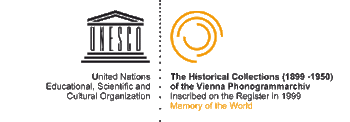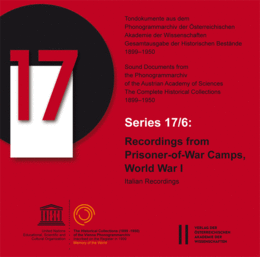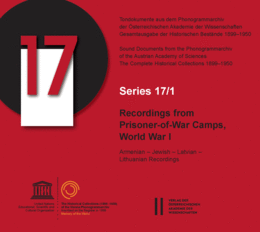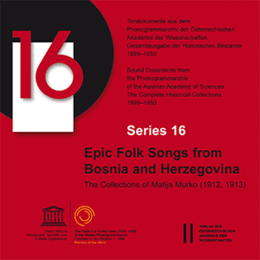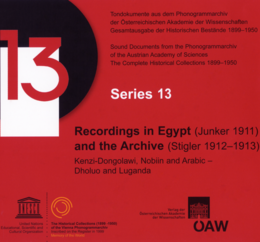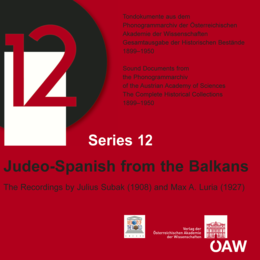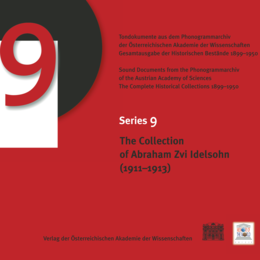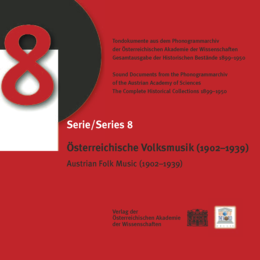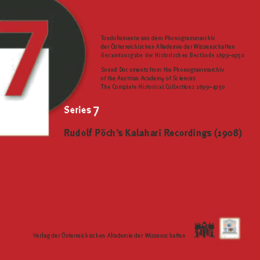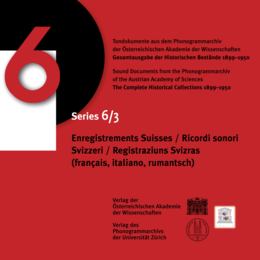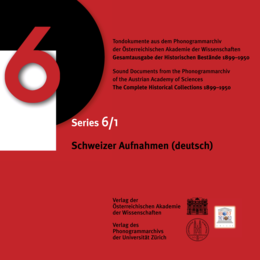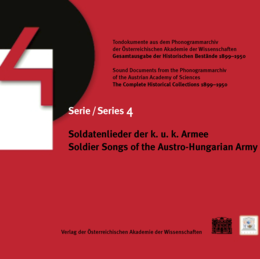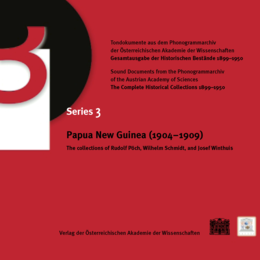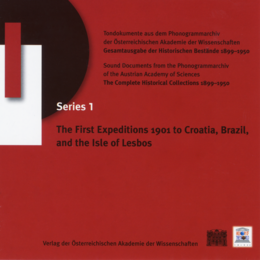The Historical Collections 1899–1950 were included in the register of UNESCO’s Memory of the World Programme as Documents of Universal Significance.
On the occasion of its 100th anniversary in 1999 the Phonogrammarchiv started to release its Historical Collections in a complete and commented edition on CD.
The Historical Collections consist of sound documents stored on mechanical sound carriers from 1899 to 1950.
Contact person: Christian Liebl
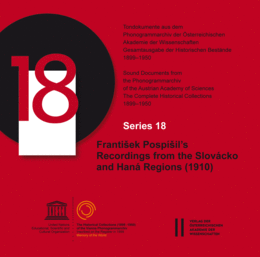
Series 18:
František Pospíšil’s Recordings from the Slovácko and Haná Regions (1910)
Editors: Gerda Lechleitner and Christian Liebl
Comments: Hana Dvořáková, Franz Lechleitner, Gerda Lechleitner, Lucie Uhlíková Transcriptions: Lucie Uhlíková
OEAW PHA CD 47, 2019
Besides recordings made in Croatian villages in South Moravia (already published in Series 11/1: “Croatian Recordings 1901–1936”), František Pospíšil’s fieldwork in the summer of 1910 resulted also in 14 recordings from the Slovácko and one from the Haná regions. Although this collection is not very large, it is of great interest: due to the border region, the specific dialects used, and the old folk songs presented, these recordings are today classified as outstanding items. Pospíšil also took photographs, now kept in the Moravian Museum in Brno. Thanks to the cooperation with its director, Hana Dvořáková, Pospíšil’s legacy from 1910, though held in two institutions, is now reunited in this publication, enriched by comments from Hana Dvořáková and Lucie Uhlíková (Institute of Ethnology of the Czech Academy of Sciences, Brno).
Published with the support of the Open Access Fonds of the Austrian Academy of Sciences (ÖAW).
Series 17/6:
RECORDINGS FROM PRISONER-OF-WAR CAMPS, WORLD WAR I
Editors: Gerda Lechleitner and Christian Liebl; co-editor: Serenella Baggio
Transcriptions, translations and comments: Maria Antonietta Arrigoni and Marco Savini, Serenella Baggio, Stefano Bannò, Silvia Calamai, Lorenzo Coveri, Antonietta Dettori, Hans Goebl, Marta Maddalon and John Trumper, Giovanni Manzari, Vito Matranga, Daniela Mereu, Nicoletta Puddu, Roberto Sottile
OEAW PHA CD 46, 2019
Series 17/1–6 is a commented source edition of sound documents featuring prisoners of war from World War I. The collection, compiled by various scholars in cooperation with the Phonogrammarchiv, comprises 250 language and music recordings. The publication of these unique sources represents an important contribution to the topic of “science in wartime” and deepens the research of various disciplines in cultural studies.
While Series 17/1–5 contain the recordings of prisoners of war from the former Tsarist army, Series 17/6 is devoted to the recordings of Italian prisoners of war, made by linguist Karl von Ettmayer in the Upper Austrian camps of Mauthausen and Marchtrenk. The recordings are accompanied by detailed written documentation (the so-called protocols), which include transcriptions and German translations. Ettmayer, however, seems to have written these protocols prior to the actual recording process, since those extant do not correspond to the numbers of the recordings. Such “errors” are rather unique and asked for a lot of detective work in order to assign them to the respective recorded contents. Thanks to the fruitful cooperation with Serenella Baggio (University of Trento) and her team, it has been possible to provide detailed linguistic analyses of the recordings. The corpus is a quarry for dialectologists, and the language samples chosen – three different tales in a rural setting – were analysed not only with regard to pronunciation, but also to dissemination and popularity. The in-depth characterisation of the respective dialects clearly shows the marked differences between the various regions, which also reflects the historico-political situation.
Series 15/2:
Indian Recordings (Schomerus 1929)
Editors: Gerda Lechleitner, Christian Liebl and Ulla Remmer
Comments and preparation of texts: Ulla Remmer
Transcriptions of various recordings and added comments: Jean-Luc Chevillard
OEAW PHA CD 48, 2019
Like the majority of Felix Exner’s collection (published as Series 15/1 in 2016), the Phonogramme made by Hilko Wiardo Schomerus were recorded in Madras (Chennai), although some 25 years later and presumably in another location. Since then, they have been preserved in the Phonogrammarchiv, but unlike Exner’s Phonogramme, which were studied by Kirste (1908) and Felber & Geiger (1912), they have not been described in the scholarly literature or edited before. The CD publication features 30 sound recordings from 1929, chiefly recitations of classical Tamil poetry. Today, these recordings are of great historical interest, as can be read in the detailed introduction. Alongside Schomerus’ professional career, his commitment to Tamil culture and his interests, which repeatedly took him to that part of the world, the documents unearthed also allow insights into his contact with the Phonogrammarchiv, his itinerary and his research methods. Thanks to the meticulous study of the texts, numerous references to contemporary issues and Schomerus’ painstaking method of working came to light. Further information concerns the biographical data of those reciting.
The transcriptions are linked to mp3 files, and the original protocols have been included as digital image files on the data disc; transcriptions of Schomerus’ German translations in the protocols have also been provided. In this publication, the sources (i.e., the sound recordings and the original protocols) are thus presented alongside the commentaries, which contain references to similar research projects as well as reflections on the value of sound recordings for modern research.
Published with the support of the Austrian Science Fund (FWF).
Series 17/1-5:
RECORDINGS FROM PRISONER-OF-WAR CAMPS, WORLD WAR I
Editors: Gerda Lechleitner, Christian Liebl and Ulla Remmer
Transcriptions, translations and comments: Niina Aasmäe, Vaiva Agkinskas, Juha-Matti Aronen, Ingeborg Baldauf, Lina Būgienė, Victor Denisov, Jasmine Dum-Tragut, Armin Eidherr, Anzor Erkomaishvili, Ildar Kharissov, Gerson Klumpp, Nikolai Kuznetsov, Britta Lange, Carl Linich, Nona Lomidze, Lilia Moskalenko, Bruria Pollak, Aldis Pūtelis, Ulla Remmer, Manana Saladze, Edwin Seroussi, Triin Todesk, Elena Vedernikova (with the help of Natali Pärtin and Nikolay Vasiliev), Rūta Žarskienė
OEAW PHA CD 41–45, 2018
As a result of the outbreak of World War I, “classical” phonographic field research came to be greatly limited. Rudolf Pöch, Professor of Anthropology and Ethnography at the University of Vienna, however, realised that the war situation would prove ‘an unprecedented opportunity for academic research’. Together with musicologist Robert Lach he exploited this opportunity in order to make extensive language and music recordings of ‘almost all peoples of European and Asian Russia’, especially in the prisoner-of-war camps at Eger (Cheb), Reichenberg (Liberec) and Theresienstadt (Terezín) in Bohemia (today’s Czech Republic). This undertaking with its 200 or so resultant recordings formed part of a larger-scale project by the Anthropological Society, carried out with the financial support of the Imperial Academy of Sciences. Apart from providing evidence for numerous minority languages, these recordings – still housed in the Phonogrammarchiv – also contain hitherto unheard-of critical commentaries by the prisoners of war, who had become objects of research under such tragic circumstances. All this underlines the enormous potential of historical recordings as sources for present-day research.
One hundred years after their creation, these sound documents, chiefly thanks to the project “Displaced Voices” (funded by the “Jubiläumsfonds der Oesterreichischen Nationalbank”, project no. 15848), were digitised in the Phonogrammarchiv and edited in cooperation with international experts, who supplied scholarly commentaries. Besides the audio CDs with the signal-enhanced recordings, each sub-series of the edition comprises a data CD with scans of the original recording protocols (i.e. the written documentation), transcriptions for orientation as well as comprehensive information on the genesis of the recordings, the researchers and the historical background. In addition, commentaries analyse the significance of the historical recordings from today’s point of view. This English-language publication thus constitutes an important contribution to the discourse of “research in wartime”, throwing a new light on this dark era.
Series 17/1–5, contents:
17/1: Armenian – Jewish – Latvian – Lithuanian Recordings
17/2: Finno-Ugric Recordings
17/3: Russian – Ukrainian Recordings
17/4: Turk-Tatar Recordings
17/5: Georgian – Avar – Jewish – Ossetian – Svanetian Recordings
Series 16:
EPIC FOLK SONGS FROM BOSNIA AND HERZEGOVINA
The Collection of Matija Murko (1912, 1913)
Editors: Gerda Lechleitner and Christian Liebl
Comments: Muhamed Arnaut, Tamara Karača Baljak, Franz Lechleitner, Gerda Lechleitner, Johannes Spitzbart, Jasmina Talam
OEAW PHA CD 40, 2017
This edition – comprising the collections of Matija Murko, made in 1912 and 1913 – releases all his recordings preserved in the Phonogrammarchiv; it also aims to shed light on Murko’s research and phonographic fieldwork in Bosnia and Herzegovina, which he carried out just before the outbreak of World War I.
Murko was convinced that his research into epic singing could be improved considerably by using a recording device. Although Murko’s activities are quite well known, e.g. from his publications (1913 and 1915), his sound recordings are still waiting to be noticed and distributed. Murko was supported by the Balkan Commission and the Phonogrammarchiv (both part of the former Imperial Academy of Sciences in Vienna); moreover, Murko’s results can be considered the basis for Milman Parry’s ground‐breaking research in the field of orality, since his meeting with Murko in Paris in 1928 stimulated Parry’s studies in former Yugoslavia.
This edition could not have been prepared had it not been for the fruitful cooperation with the University of Sarajevo, Academy of Music, Department of Musicology and Ethnomusicology. The two ethnomusicologists, Jasmina Talam and Tamara Karača Beljak, have been known to us for years, and so it was a welcome opportunity to have them as specialists for this publication. It is to their efforts that we owe the transcriptions of the (partly rather bad) recordings and the insightful comments concerning Murko’s research and results in relation to contemporary and later scholars. Moreover, Muhamed Arnaut compiled a dictionary of old and lesser known Bosnian words found in Murko’s recordings for better understanding of the epic songs as recited more than 100 years ago. For ethnomusicologists and researchers of folk literature, Murko’s recordings are extremely valuable because they represent a manner of performing epic songs which one can no longer find in contemporary live folk musical practice.
Sound sample
Ph 2148: Beginning of the song “Je li rano, je l’ sunce visoko?” (Is it early, is the sun high?)
Sung and played (violin) by Avdo Mehić, 25, musician from Mostar.
Recorded September 10th, 1913 in Mostar.
Series 15/1:
INDIAN RECORDINGS
Exner 1904–05, Archive 1918
Editors: Ulla Remmer, Christian Liebl, Gerda Lechleitner.
Comments and preparation of texts: Ulla Remmer.
OEAW PHA CD 38, 2016
Series 15/1 of the Indian Recordings comprises two audio CDs with the oldest sound documents of Indian origin preserved in the Phonogrammarchiv; those dating from 1929 (Schomerus Collection) will be published as Series 15/2 in due course. The first of the two collections in the present edition was compiled by the meteorologist Felix Exner in the course of his research trip to India in 1904–05; its total of 68 recordings contain primarily samples of recitation of Sanskrit and Vedic literature, but also a few works in Malayalam, Telugu, Marathi, Hindustani and Tamil. In 1918, another eight recordings were made in the Phonogrammarchiv in Vienna; they feature Har Dayal and Umrao Singh Sher-Gil, two outstanding personalities in the anti-colonial movement of India, reciting literature in Sanskrit, Hindi, Urdu, Braj Bhasha and Awadhi.
With the present edition, the historical Indian holdings of the Phonogrammarchiv are for the first time made publicly audible. The enclosed documentation provides information about the context of the recordings and the texts chosen as well as about the Indian reciters and other persons or institutions involved.
Series 14:
FRIEDRICH SCHÜRR’S RECORDINGS FROM ROMAGNA (1914)
Editors: Cristina Ghirardini, Gerda Lechleitner, Christian Liebl.
Comments: Sanzio Balducci, Cristina Ghirardini, Franz Lechleitner, Gerda Lechleitner, Christian Liebl and Nadja Wallaszkovits.
OEAW PHA CD 37, 2014
The present series contains a unique collection of 23 Phonogramme featuring various Romagnol dialects. They were recorded between July and August 1914 in Ravenna and Forlì, Italy, by Friedrich Schürr, the Vienna-born Romance scholar. His pioneering research into Romagnol, cut short by the outbreak of World War I, was preceded by comparative diachronic investigations which he conducted during several stays in Italy from 1910 onwards. Primarily aiming at a comprehensive account of stressed vowels in Romagnol dialects, Schürr eventually decided to make use of the phonograph, which enabled the recorded text to be listened to and checked repeatedly. His subsequent application to the Phonogrammarchiv was granted, and an Archiv-Phonograph put at his disposal. The recordings comprise not only Schürr’s 57 so-called Normalsätze (standardised sentences created for his research purposes), but also the names of weekdays and months, individual phrases and proverbs as well as dialect poems or prose. Schürr’s approach of using the phonograph in documenting the dialects of Romagna is the more important since it constitutes the first sound documentation ever made in the field of dialectology as regards Italy.
The publication at hand is the result of the fruitful cooperation between the Phonogrammarchiv and the Centro per il Dialetto Romagnolo of the Fondazione Casa di Oriani. Thanks to the latter’s successful efforts, the Fondazione Cassa di Risparmio di Ravenna, with its library preserving the legacy of Friedrich Schürr, finally agreed to fund this project. The present multimedia publication consists of an audio CD, a data CD and a booklet (with a substantial contribution by dialectologist Sanzio Balducci). In addition to digital images of the original documentation accompanying the recordings, the data CD also provides scans of Schürr’s publication of 1917 (resulting from his phonographic field research) and relevant correspondence as well as Italian translations of most of the booklet texts, making it a more or less bilingual edition.
Series 13:
RECORDINGS IN EGYPT (JUNKER 1911) AND THE ARCHIVE (STIGLER 1912–1913)
Kenzi-Dongolawi, Nobiin and Arabic – Dholuo and Luganda
Editors: Clemens Gütl, Gerda Lechleitner, Christian Liebl.
Comments: Michael Achenbach, Marianne Bechhaus-Gerst, Clemens Gütl, Daniel Ochieng Orwenjo and Birgit Pack.
OEAW PHA CD 35, 2014
Two CD series devoted to African languages have so far been released by the Phonogrammarchiv: Rudolf Pöch’s Kalahari Recordings (1908) and The Collection of Father Franz Mayr: Zulu Recordings 1908. The present edition combines two further historical collections of spoken and sung recordings from the African continent. The first contains 14 field recordings (in Kenzi-Dongolawi, Nobiin and Arabic) made in winter 1911 during the Linguistic Expedition to Nubia, led by the famous Egyptologist Hermann Junker. The second collection includes six sound documents in Dholuo and Luganda; recorded at the Phonogrammarchiv between 1912 and 1913 at the instigation of the physiologist Robert Stigler, they feature the voices of “Kilimandjaro” Mori Duise and Simon Kasajja. The result of both international and interdisciplinary collaboration, the present publication again follows the well-established concept of the Phonogrammarchiv’s CD edition: alongside the digitised original recordings and protocols, it comprises scholarly contributions on the context and protagonists as well as modern transcriptions of the recording contents complete with English translations.
Series 12:
JUDEO-SPANISH FROM THE BALKANS
The Recordings by Julius Subak (1908) and Max A. Luria (1927)
Editor: Christian Liebl. Editorial assistance: Gerda Lechleitner.
Comments: Paloma Díaz-Mas, Christian Liebl, Aldina Quintana Rodríguez and Edwin Seroussi (in collaboration with Rivka Havassy).
OEAW PHA CD 28, 2009
During 1908/1909, Julius Subak (1872–1936), an Austrian Romance scholar, was entrusted by the Balkan Commission of the Imperial Academy of Sciences to record, both in writing and phonographically, the Judeo-Spanish of the Balkan Peninsula. He conducted his primarily linguistic investigation among the descendants of those Sephardim who – expelled from Spain in 1492 – had sought refuge in the Balkans, then part of the Ottoman Empire. The resulting 15 Phonogramme are said to be the first recordings of Judeo-Spanish (or Ladino) made for scholarly purposes. They contain chiefly poems and romances (the orally transmitted ballads from medieval Spain), but also songs and a passionate appeal to preserve the Judeo-Spanish language. Subak even succeeded in recording prominent representatives of Sarajevo’s Sephardic community – such as Abraham A. Cappon, who is reciting from his own works.
In 1927, the US-American Max A. Luria (1891–1966) undertook linguistic field research in Monastir (present-day Bitola, FYROM) as part of his doctoral dissertation. Equipped with an Archiv-Phonograph, he made a total of 26 recordings which – featuring proverbs and dialogues, but above all numerous konsežas (folktales) – bring to life again this particularly conservative dialect of Judeo-Spanish.
The contributions by Aldina Quintana Rodríguez, Edwin Seroussi and Rivka Havassy as well as Paloma Díaz-Mas highlight the importance of these unique sound documents, especially for Judeo-Spanish dialectology, but also for the study of Sephardic music and literature. Together with the transcriptions, they constitute a valuable supplement to the recorded witnesses of a once flourishing culture on the eve of cataclysmic changes.
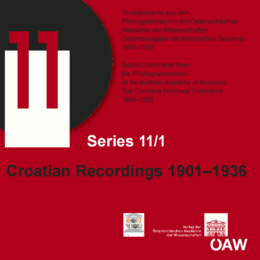
Series 11/1:
CROATIAN RECORDINGS 1901–1936
Editors: Gerda Lechleitner and Grozdana Marošević. Assistance: Christian Liebl and Jakša Primorac.
Comments: Walter Breu, Naila Ceribašić, Radoslav Katičić, Franz Lechleitner, Gerda Lechleitner, Mijo Lončarić, Grozdana Marošević, Dario Marušić, Gerhard Neweklowsky and Jakša Primorac.
OEAW PHA CD 27, 2009
The basic idea underlying Series 11 – Croatian Recordings – was conceived by Gerda Lechleitner (Phonogrammarchiv of the Austrian Academy of Sciences) and Grozdana Marošević (Institute of Ethnology and Folklore Research, Zagreb) when considering its publication as a co-operation of both institutions. They decided to include all the material housed in the Vienna Phonogrammarchiv and recorded in the first half of the 20th century, either on the territory of today’s Croatia or among Croats living outside Croatia. Because of its size, Series 11 will be published in two parts: the first part (Series 11/1 – Croatian Recordings 1901–1936) is made up of all the smaller collections, while the second part will comprise the most extensive collection among these holdings, compiled by Milovan Gavazzi and Božidar Širola during the 1920s in co-operation between the Phonogrammarchiv and the Department of Folk Music, founded in 1921 as part of the Ethnographic Museum in Zagreb.
This publication features the very first recordings made by Milan Rešetar in 1901 during his investigation of the dialect boundaries in northern Croatia; in 1907, Rešetar again took a recording machine with him when conducting field research in Acquaviva Collecroce (Kruč) near Campobasso in Molise to study the life and culture of Croats living there. In Istria, only single recordings were made of Istro-Romanian and Italian dialects, while František Pospíšil’s project of recording Croats in Moravia in 1910 generated a greater output. Matija (Mathias) Murko recorded and studied epic songs in 1913; and Croatian soldier songs, recorded in Karlovac in Croatia during World War I, are included as well. Quite often, the Phonogrammarchiv took the opportunity to invite visitors to make a recording, e.g. Josip (Josef) Florschütz (1912) or four singers from Parndorf (Burgenland Croats, 1936). Mention must be made of the sizeable collection of Josip Široki, who was author, performer and technician all in one person. His collection (1913–1920) includes items of all South Slavic music styles (he did not only sing but also perform on several instruments) and various dialects (spoken by him) – it is, as far as we know, our only collection compiled in that way.
Series 10:
THE COLLECTION OF FATHER FRANZ MAYR
Zulu Recordings 1908
Editor: Gerda Lechleitner.
Comments: Clemens Gütl and August Schmidhofer.
OEAW PHA CD 25, 2006
In contrast to other historical holdings of the Phonogrammarchiv whose publication has been eagerly awaited by the scientific community, the Zulu recordings made by Father Franz Mayr in the former British colony of Natal (South Africa) have not yet gained such prominence. Clemens Gütl, who a few years ago first drew attention to the Tyrolean priest and his role as a missionary, substantially contributed to the commentary in the present volume, contextualising the collection from a modern perspective and characterising Mayr as an enthusiastic collector and musically interested person. The wide range of informants recorded by Mayr included young school girls, an old “traditional” healer, non-Christian Zulu people, and Zulus who had already accepted Christianity and European customs (at least formally).
As August Schmidhofer explains in his contribution, Mayr’s collection embraces a wide range of musical styles performed in Southern Africa at the beginning of the 20th century. While the greatest part of his collection represents various autochthonous styles, there are also several examples of European hymns and new compositions employing European musical techniques. They range from prayers and extempore speech to war and hunting songs as well as the European-influenced dance songs of the Christian Zulus, which, according to Mayr, were composed “by the young Christian Zulus themselves and not taught by missionaries”. Other songs tell us about historical events like the Zulu or Boer Wars, or the Bambata “rebellion” and the relationship between the black population of Natal and the white colonialists. They also name and praise famous Zulu “kings” such as Cetshwayo or Dinizulu, offer some insights into social events like marriages and occasionally contain so-called izibongo, recited praises or eulogies. With the exception of two recordings, which feature music in Baca, a dialect of Swati, all the recordings document samples of Zulu; they will not only appeal to ethnomusicologists and linguists, but also attract the attention of a general public interested in African culture and history, especially in the regions of their origin.
THE COLLECTION OF ABRAHAM ZVI IDELSOHN (1911–1913)
Editor: Gerda Lechleitner.
Comments: Philip V. Bohlman and Edwin Seroussi.
OEAW PHA CD 23, 2006
The recordings of Abraham Zvi Idelsohn belong to one of the most famous collections of the Phonogrammarchiv. This publication is essentially the result of intensive international cooperation over three continents, bringing together the Hebrew University of Jerusalem (Jewish Music Research Centre, Faculty of Humanities), the Jewish National and University Library (Music Department and National Archives), the Archives for Historical Documentation (AHD) in Brighton/Mass., and the University of Chicago (Department of Music) as well as the Phonogrammarchiv of the Austrian Academy of Sciences.
Abraham Zvi Idelsohn is famous for his manifold activities in the research of Jewish music, which he pursued much more intensely than any musicologist or collector of melodies. Adopting a similar approach as in his opus magnum, the ten-volume Hebräisch-orientalischer Melodienschatz (Thesaurus of Oriental Jewish Music, published between 1914 and 1932), he made phonographic recordings not only of Yemenite, Babylonian, Syrian, Persian, Moroccan Jews and Oriental Sephardim, but also of Arabs and members of the Eastern Churches residing in Jerusalem between c. 1908 and 1914, as well as of the Samaritans from Nablus. His main interests comprised the liturgical traditions of all these religious groups and the maqam system of urban Arabic music.
Series 8:
ÖSTERREICHISCHE VOLKSMUSIK (1902–1939)
Comments: Helga Thiel and Walter Deutsch.
OEAW PHA CD 22, 2004
Unlike other countries Austria does not possess any great number of folk music recordings from before the 1950s. This has made it all the more important to publish the holdings of early audio documents of Austrian folk music from 1902 to 1939. The publication comes in time for the 100th anniversary of the Austrian Folk Music Society. It features 84 recordings of songs as well as calls, yodelers and instrumental music from the Salzkammergut and the Pinzgau that were recorded at different times and occasions.
For the first time in the series the accompanying CD-ROM contains not only the digitised original protocols but also the music transcriptions.
Series 7:
RUDOLF PÖCH’s KALAHARI RECORDINGS (1908)
Comments by Regine Allgayer-Kaufmann et al.
OEAW PHA CD 19, 2003
Series 7 comprises the recordings made by Rudolf Pöch in the course of his Kalahari expedition which he started at the end of 1907 on behalf of the Imperial Academy of Sciences in Vienna. His aim was anthropological and ethnographical research amongst the “Bushmen” of the Kalahari, augmented by botanical, zoological, geographical and geological studies. The film and sound recordings were made between April and August 1908.
The language recordings are of significance especially in the field of comparative linguistics, as they may give insight into aspects of linguistic change in Naro. The music recordings may well represent the oldest sound documents of polyphony of the Khoisan-speaking peoples in the south-west of Africa.
Series 6/1–3:
SWISS Recordings
In cooperation with the Phonogrammarchiv of the University of Zurich and thanks to generous financial contributions by Memoriav – Verein zur Erhaltung des audiovisuellen Kulturgutes der Schweiz, Robert J. Schwarzenbach-Fonds and the Zürcher Universitätsverein we have been able to publish the Schweizer Aufnahmen.
These recordings result from the cooperation between Vienna and Zurich, begun in 1909 and ultimately leading to the foundation of the Zürcher Phonogrammarchiv. The Zurich recordings were made with Vienna’s Archiv-Phonograph, while archiving as such was shared between Zurich and Vienna. Thanks to renewed close cooperation one hundred years later, the historical recordings of Swiss dialects – largely housed in both archives, but occasionally only in Vienna or Zurich – have now been brought together; they will be published as Series 6 in three volumes; volume 1 & 2: Schweizer Aufnahmen (deutsch), volume 3: Enregistrements Suisses / Ricordi sonori Svizzeri / Registraziuns Svizras (français, italiano, rumantsch).
Serie 6/3:
ENREGISTREMENTS SUISSES / RICORDI SONORI SVIZZERI / REGISTRAZIUNS SVIZRAS (français, italiano, rumantsch)
Comments: Jürg Fleischer, Thomas Gadmer, Ricarda Liver, Raphaël Maître, Mario Vicari.
OEAW PHA CD 18, 2002.
2 CDs comprise linguistic recordings from the French, Italian, and Rhaeto-Romanic regions of Switzerland.
Series 5/1–3:
THE COLLECTIONS OF RUDOLF TREBITSCH (1906–1913)
A medical doctor and ethnologist, Rudolf Trebitsch was able to finance his travels himself and systematically recorded samples of language and music amongst the Inuit of Greenland, the Celtic peoples, and the Basques. Being amongst the earliest recordings in their respective fields, his collections have always attracted the interest of specialists. The considerable size of his total collection and its three distinct parts suggested a subdivision of the series into three different volumes.
Serie 5/3:
BASQUE RECORDINGS 1913
Comment: Bernhard Hurch.
OEAW PHA CD 15, 2003
Hugo Schuchardt, Professor of Romance Philology, recommended Trebitsch to Julio de Urquijo, who gave him every conceivable support. The recordings systematically cover the whole of the Basque region; they include the multitude of dialect varieties and the voices of various historic figures from Basque cultural life, like R.M. de Azkue or Pierre Broussain.
Serie 5/2:
CELTIC RECORDINGS – IRELAND, WALES, BRITTANY,
ISLE OF MAN, AND SCOTLAND (1907–1909)
Comment: Ulla Remmer.
OEAW PHA CD 14, 2003
During three successive summers spent in Celtic-speaking areas of Europe Rudolf Trebitsch established an unparalleled phonographic collection of Celtic languages and folk music. The CD also contains voice portraits of famous personages like Joseph Loth or Peter O’Leary.
Serie 5/1:
RECORDINGS FROM GREENLAND (KALAALIT NUNAAT) 1906
Comment by Michael Hauser.
OEAW PHA CD 13, 2003
The CD comprises spoken pieces (poems, legends, stories and accounts of events) as well as Europeanised and traditional songs like drum songs or wordless nonsense songs, and instrumental dance tunes.
Series 4:
SOLDATENLIEDER DER K. U. K. ARMEE
Comment: Oskár Elschek.
OEAW PHA CD 11, 2000
During World War I, the Phonogrammarchiv – on request of the former k.u.k. Kriegsministerium – recorded soldier songs in almost all languages spoken in the Austro-Hungarian monarchy. The recordings include solo and choir songs (partly accompanied by instruments) as well as instrumental pieces.
Series 3:
PAPUA NEW GUINEA (1904–1909)
The collections of Rudolf Pöch, Wilhelm Schmidt, and Josef Winthuis.
Comments: Don Niles.
OEAW PHA CD 9, 2000.
The core of the series Papua New Guinea (1904–1909) is made up of the famous recordings by Rudolf Pöch, a physician and anthropologist who moved freely between German New Guinea and British New Guinea (Papua), and then on to Dutch New Guinea. Schmidt’s recordings represent the first recording of Papua New Guinea traditional music under studio conditions. Winthuis’s 1908–09 recordings in the Tolai area mark the beginning of the important contribution of missionaries to the production of field recordings.
